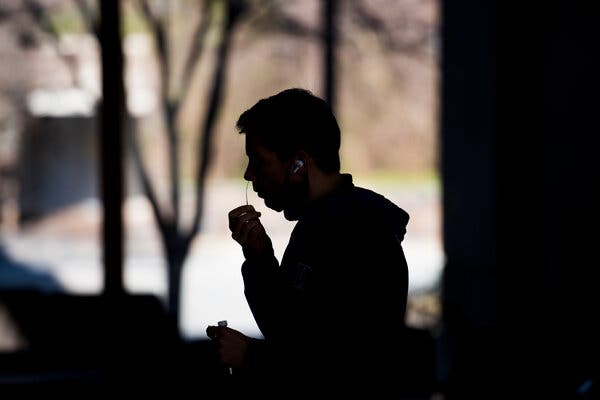AdvertisementContinue reading the main storySupported byContinue reading the main storyPandemic Forces F.D.A. to Sharply Curtail Drug Company InspectionsThe steep decline in oversight has stalled a number of new drug applications. The agency says it is trying to protect its employees but critics say inspectors should be considered essential workers and do their jobs.The F.D.A. conducted more than 1,671 inspections of foreign and domestic drug manufacturing facilities in 2019. Last year, that number dropped by more than half, to 742. Credit…Ariana Lindquist/BloombergMarch 9, 2021, 5:00 a.m. ETThe Covid-19 pandemic has forced the Food and Drug Administration to postpone hundreds of drug company inspections, creating an enormous backlog that is delaying new drug approvals and leading the industry to warn of impending shortages of existing medicines.Pandemic-related travel restrictions and safety concerns have also hampered the F.D.A.’s ability to ensure the safety of the ever-increasing number of imported medicines, which make up more than 60 percent of the drugs sold in the United States.“Regardless of where drugs are manufactured, domestically or overseas, the F.D.A. has the responsibility to ensure they are effective and safe,” said Mary Denigan-Macauley, director of health care, public health and private markets for the Government Accountability Office, a congressional watchdog agency. “Any drop in inspections, or backlog, is concerning.”The numbers show a steep decline. The F.D.A. conducted 52 inspections of domestic pharmaceutical plants between March 2020, when the pandemic took hold in the U.S., and Oct. 1, compared with 400 during the same months in 2019, according to the G.A.O. Inspections of foreign manufacturing facilities have been at a virtual standstill for months.In an interview, F.D.A. officials said they sharply curtailed the inspections to protect their investigators, following guidelines from the Centers for Disease Control and Prevention, which discouraged federal employees from travel during the pandemic.But some people in both industry and public health communities say that federal drug inspections are essential, and that the agency should bypass travel restrictions by taking precautions, including wearing proper personal protective equipment.“I think they can and they should,” said Dr. Michael Carome, director of Public Citizen’s Health Research Group, a nonprofit advocacy organization. “They should be considered essential workers and they should be vaccinated as soon as possible. And they should be provided with N95s masks, gowns and gloves to ensure their own safety during travel and during the inspection.”Dr. Denigan-Macauley said that the F.D.A. has postponed more than 1,000 surveillance inspections — the routine visits that the agency conducts to check for adherence to good manufacturing practices. “Drugs that are waiting for pre-approval inspections will also have a backlog,” she said.In interviews, F.D.A. officials denied that the dramatic drop in inspections has slowed drug approvals. But a number of drug companies, including Spectrum Pharmaceuticals, Biocon Biologics and Bristol Myers Squibb, has issued statements noting deferred F.D.A. action because of the agency’s inability to conduct inspections.In October, Spectrum announced that the F.D.A. had deferred action on its application for Rolontis, a treatment for cancer patients who have a very low number of certain white blood cells, because it could not inspect the manufacturing plant the company uses in South Korea.In late December, Biocon Biologics notified shareholders that the F.D.A. deferred action on its joint application with Mylan for a proposed biosimilar to Avastin, a cancer drug.Bristol Meyers Squibb announced in November that the F.D.A. would miss its November deadline for taking action on a lymphoma treatment, lisocabtagene maraleucel because it could not inspect a third-party Texas manufacturing plant. The agency eventually did complete its inspection and approved the drug last month.In addition, Nivagen, a pharmaceutical company specializing in generic versions of injectable medications, filed an application in January 2019 for an expedited review of a generic version of a drug used in cardiac therapy and for other problems. In March 2019, the F.D.A. granted its request for what is known as a competitive generic therapy designation, for products that the F.D.A. believes should get high priority for consideration. Then the pandemic hit, and the F.D.A. pushed the company’s inspection back twice, according to Jay Shukla, Nivagen’s chief executive officer. He said he does not know when one will be scheduled.Dr. Erin Fox, who tracks drug shortages for the American Society of Health System Pharmacists, says shortages of the brand name version of the drug, which is made by only one company in its injectable form, have occurred on and off since 2006. That’s why Mr. Shukla said he decided it would be a good product for his new business.“For me, a small start-up company, our growth depends on this product for the manufacturing I want to build in the U.S.,” said Mr. Shukla. “It all depends on this approval. The review is done, it’s only pending the facility inspection. We appreciate the hard work the F.D.A. is doing, but we are suffering too.”Mr. Shukla has proposed an alternative — a virtual inspection using remote video technology to permit the F.D.A. inspector to view inside the facility. The pharmaceutical industry has been pressing the F.D.A. to adopt remote inspections, but the agency said that it is still evaluating the idea, as it has been doing for months. So far, it has conducted virtual sessions sparingly, generally more for viewing a company’s documents than for actual remote viewing of a manufacturing plant.Donald D. Ashley, director of compliance for the agency’s Center for Drug Evaluation and Research, said he was wary of relying heavily on remote viewing, especially for inspections at facilities that had had past violations.“When we go back to reassess whether they have corrected their ways, we want to use our most robust tool, and that’s an on site inspection,” Mr. Ashley said.F.D.A. inspectors at a mail facility in New York in 2018. The agency cited pandemic-related restrictions and safety concerns for hampering its ability to conduct on-site reviews of the increasing number of imported medicines.Credit…Michael J. Ermarthh/U.S. Food and Drug AdministrationDuring most drug company inspections, investigators review the company’s internal records and scrutinize the building, checking how supplies are handled, reviewing quality controls and determining whether the company complies with good manufacturing practices. The F.D.A. conducts three types of inspections: pre-approval inspections when companies have filed applications for new drugs; routine surveillance inspections, which it tries to do at least once every five years; and those following up on a problem.Proponents of remote audits say they can do the same thing virtually. Peter Miller, president of Dynamic Compliance Solutions, of New Jersey, which helps life science companies comply with F.D.A. regulations, says his remote audit kit can do a great inspection. The kit features a tiny 360-degree camera, which an on-site host carries on a tripod while the investigator watches on a computer screen.“The inspector can say, ‘I see a stack of boxes there. Can we move a little closer? I’d like to see if they have proper stickers,’ ” he said. “I believe the auditor should be in control of what they are looking at. We do a livestream, unrecorded broadcast.”Industry lawyers believe the F.D.A. is being too fussy in rejecting remote inspections, given the current backlog. Mark I. Schwartz, a former F.D.A. deputy director who had oversight of inspections conducted by the agency’s Center for Biologics Evaluation and Research, thinks wider use of remote inspections is way overdue. Mr. Schwartz believes that when done properly, remote inspections will yield similar results to in-person visits — which he said more than a dozen of his clients are desperate to have done.“The suggestion that being on-site makes a whole hell of a difference in finding things is a fallacy,” said Mr. Schwartz, now a director at Hyman, Phelps & McNamara, a law firm with a large pharmaceutical industry practice. At best, Mr. Schwartz said, investigators on-site see only about 15 percent of a company even when they are there in person.The issue has drawn congressional attention. Dr. Denigan-Macauley is scheduled to testify on Tuesday before the House appropriations subcommittee that oversees the F.D.A. Representative Sanford Bishop, a Georgia Democrat who is chairman of the panel, said, “The pressure to ensure F.D.A. is still able to assess the safety and efficacy of the drug supply grows every day. ”While public health experts are troubled by the big drop in inspections, most believe that virtual inspections would be a poor substitute for in-person reviews.“Remote inspections just aren’t going to cut it,” Dr. Carome said. “Often the F.D.A. identifies serious problems and if you aren’t on-site, those will go undetected.”“There have been examples where F.D.A. have found filthy conditions in the manufacturing facility or they found rodents or insects that could contaminate products,” Dr. Carome said. “The facility isn’t going to show you that.”The F.D.A. has increasingly relied on electronic submission of manufacturing records during the pandemic, but prefers to view them in person to confirm accuracy. Mr. Ashley of the F.D.A. recalled a 2019 inspection of an over-the-counter drug manufacturer in China, where an investigator found falsification of records that would not have been detected by simply studying them on line.“The front management presented these to our investigator, who noticed that the documents were dated a long time ago, but the ink was still wet,” Mr. Ashley said. “We asked them to recall all their drug products.”The F.D.A. was already behind on inspections before the pandemic, according to congressional investigators, particularly those overseas. The G.A.O. placed part of the blame on the lack of investigators qualified to conduct the inspections.But the watchdog also questioned the wisdom of the F.D.A.’s practice of giving foreign manufacturers up to 12 weeks notice before the inspection, potentially enabling them to fix or hide problems. The pandemic has also prompted the F.D.A. to provide domestic facilities advance notice of its visits, the G.A.O. noted. Another problem is the F.D.A.’s reliance on translators chosen by the company being inspected.Dr. Denigan-Macauley of the G.A.O. said that from March to October 2020, the F.D.A. conducted only three foreign inspections that it considered “mission critical,” compared to more than 600 during the same time period in 2019 and 2018. The G.A.O. also said that the F.D.A. was able to put 54 overseas manufacturers on what are called “import alerts” by sampling their products, rather than doing an inspection. An import alert permits the F.D.A. to block that company’s products from entering the United States.The F.D.A. confirmed that the vast majority of foreign inspections continue to be postponed.“If this continues,” Dr. Denigan-Macauley said, “they are going to be very challenged.”AdvertisementContinue reading the main story
Read more →







